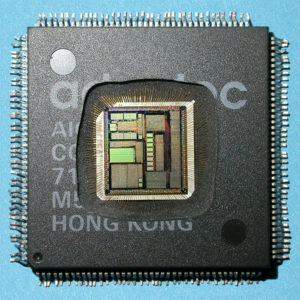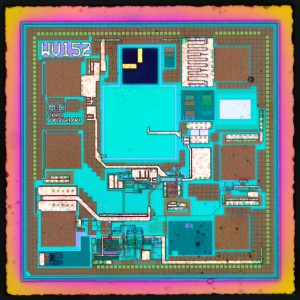Posts Tagged ‘copy chip protected software’
 Copy Chip PIC16F73 Program
Copy Chip PIC16F73 Program
We can Copy Chip PIC16F73 Program, please view the Chip PIC16F73 features for your reference:
The PIC16C7X is a family of low-cost, high-performance, CMOS, fully-static, 8-bit chips with integrated analog-to-digital (A/D) converters, in the PIC16CXX mid-range family. All PIC16/17 chips employ an advanced RISC architecture. The PIC16CXX chip family has enhanced core features, eight-level deep stack, and multiple internal and external interrupt sources.
The separate instruction and data buses of the Harvard architecture allow a 14-bit wide instruction word with the separate 8-bit wide data. The two stage instruction pipeline allows all instructions to execute in a single cycle, except for program branches which require two cycles. A total of 35 instructions (reduced instruction set) are available. Additionally, a large register set gives some of the architectural innovations used to achieve a very high performance.
PIC16CXX chips typically achieve a 2:1 code compression and a 4:1 speed improvement over other 8-bit chips in their class. The PIC16C72 has 128 bytes of RAM and 22 I/O pins.
In addition several peripheral features are available including: three timer/counters, one Capture/Compare/PWM module and one serial port. The Synchronous Serial Port can be configured as either a 3-wire Serial Peripheral Interface (SPI) or the two-wire Inter-Integrated Circuit (I 2C) bus. Also a 5-channel high-speed 8-bit A/D is provided. The 8-bit resolution is ideally suited for applications requiring low-cost analog interface, e.g. thermostat control, pressure sensing, etc.
The PIC16C73/73A devices have 192 bytes of RAM, while the PIC16C76 has 368 byes of RAM. Each device has 22 I/O pins. In addition, several peripheral features are available including: three timer/counters, two Capsuited for applications requiring low-cost analog interface, e.g. thermostat control, pressure sensing, etc.
The PIC16C7X family has special features to reduce external components, thus reducing cost, enhancing system reliability and reducing power consumption which can be used for MCU Cracking.
There are four oscillator options, of which the single pin RC oscillator provides a low-cost solution, the LP oscillator minimizes power consumption, XT is a standard crystal, and the HS is for High Speed crystals. The SLEEP (power-down) feature provides a power saving mode. The user can wake up the chip from SLEEP through several external and internal interrupts and resets.
A highly reliable Watchdog Timer with its own on-chip RC oscillator provides protection against software lock up.
A UV erasable CERDIP packaged version is ideal for code development while the cost-effective One-Time-Programmable (OTP) version is suitable for production in any volume.
The PIC16C7X family fits perfectly in applications ranging from security and remote sensors to appliance control and automotive. The EPROM technology makes customization of application programs (transmitter codes, motor speeds, receiver frequencies, etc.) extremely fast and convenient. The small footprint packages make this chip series perfect for all applications with space limitations.
Low cost, low power, high performance, ease of use and I/O flexibility make the PIC16C7X very versatile even in areas where no chip use has been considered before (e.g. timer functions, serial communication, capture and compare, PWM functions and coprocessor applications).
 Copy Chip AT89S8252 Flash
Copy Chip AT89S8252 Flash
Copy Chip AT89S8252 Flash content has to decapsulate the silicon package of AT89S8252 which act as the 1st layer of tamper resistent protection, unlock Microcontroller AT89S8252 also needs to modify its security fuse bit;
Features
· Compatible with MCS®51 Products
· 8K Bytes of In-System Reprogrammable Downloadable Flash Memory
– SPI Serial Interface for Program Downloading
– Endurance: 1,000 Write/Erase Cycles
2K Bytes EEPROM
– Endurance: 100,000 Write/Erase Cycles
4V to 6V Operating Range
Fully Static Operation: 0 Hz to 24 MHz
Three-level Program Memory Lock
256 x 8-bit Internal RAM
32 Programmable I/O Lines
Three 16-bit Timer/Counters
Nine Interrupt Sources
Programmable UART Serial Channel
SPI Serial Interface
Low-power Idle and Power-down Modes
Interrupt Recovery from Power-down
Programmable Watchdog Timer
Dual Data Pointer
Power-off Flag
Description
The AT89S8252 is a low-power, high-performance CMOS 8-bit microcontroller with 8K bytes of downloadable Flash programmable and erasable read-only memory and 2K bytes of EEPROM. The device is manufactured using Atmel’s high-density nonvolatile memory technology and is compatible with the industry-standard 80C51 instruction set and pinout.
The on-chip downloadable Flash allows the program memory to be reprogrammed In-System through an SPI serial interface or by a conventional nonvolatile memory programmer. By combining a versatile 8-bit CPU with downloadable Flash on a monolithic chip, the Atmel AT89S8252 is a powerful microcontroller, which provides a highly-flexible and cost-effective solution to many embedded control applications.
The AT89S8252 provides the following standard features: 8K bytes of downloadable Flash, 2K bytes of EEPROM, 256 bytes of RAM, 32 I/O lines, programmable watchdog timer, two data pointers, three 16-bit timer/counters, a six-vector two-level interrupt architecture, a full duplex serial port, on-chip oscillator, and clock circuitry.
In addition, the Copy Chip AT89S8252 is designed with static logic for operation down to zero frequency and supports two software selectable power saving modes. The Idle Mode stops the CPU while allowing the RAM, timer/counters, serial port, and interrupt system to continue functioning. The Power-down mode saves the RAM contents but freezes the oscillator, disabling all other chip functions until the next external interrupt or hardware reset.
The downloadable Flash can be changed a single byte at a time and is accessible through the SPI serial interface. Holding RESET active forces the SPI bus into a serial programming interface and allows the program memory to be written to or read from unless lock bits have been activated.

